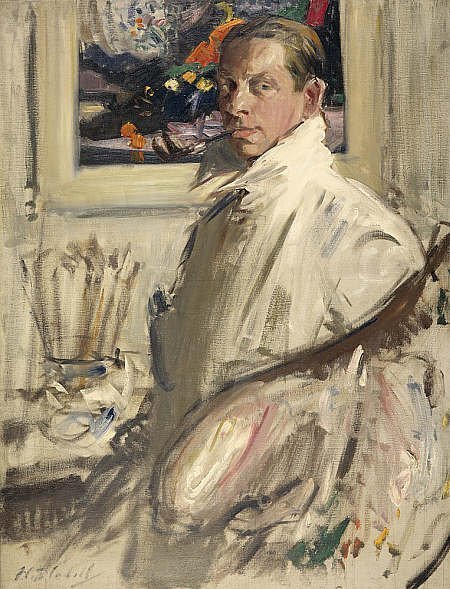
In my last blog, I introduced you to the four painters who would later become known as the Scottish Colourists. In that first blog I looked at the life of Samuel Peploe and today I am concentrating on the life and works of another member of the group, Francis Campbell Boileau Cadell. Cadell was born in Edinburgh in April 1883. His father was Francis Cadell, an Edinburgh surgeon and his mother was Mary Boileau, a lady of French extraction. His sister was Jean Cadell, who would later become a well-known character actress. As a boy, Cadell showed an aptitude for drawing and was educated at the Edinburgh Academy where he studied art. When he was sixteen years of age and had completed his studies, on the advice of the Scottish landscape and figure painter, Arthur Melville, who was also the godfather to Cadell’s younger brother, Cadell went to Paris, chaperoned by his mother, in order to study art at the Académie Julian. He remained at the Academy for three years, during which time his exposure to the works of French artists of the time was to have an intense and enduring effect on his paintings. During his first year at the Academy he was delighted to have one of his watercolours accepted for exhibiting at that year’s Paris Salon. Whilst he was studying in the French capital he met one of the other Scottish Colourists, Samuel Peploe, and the two soon became friends. The artwork of Peploe, who was twelve years his senior, was to prove to be a great influence on his work.
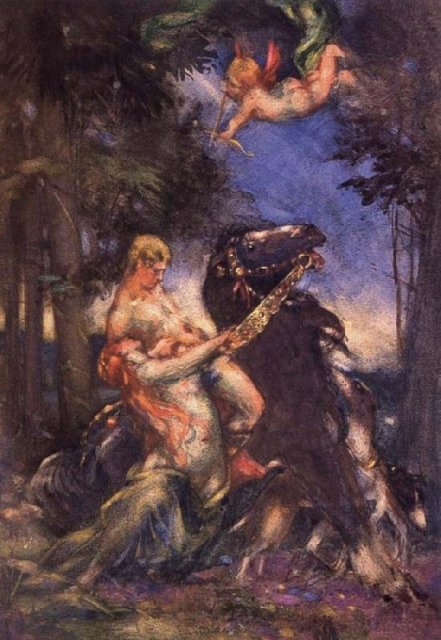
Cadell returns to Scotland in 1902 and, for the first time, exhibited work at the Royal Scottish Academy. The genre of his works was varied. He painted portraits as well as landscapes and also dabbled with mythical subjects, such as his work entitled Mythical Scene which he completed around 1907. In 1906 he and his family moved to Munich and the following year he enrolled at the Akademie der Bildenden Künste in Munich. A year later, in 1908, his mother died and the family returned home to Edinburgh. That year, Cadell held his first one-man show at the gallery of the Edinburgh picture dealers, Doig, Wilson and Wheatley. Cadell remained in Edinburgh until 1914, with just a brief time away on a painting trip to Venice, a city, which provided him with the ideal setting for his natural aptitude as a colourist. Cadell loved everything about Edinburgh and was impressed by the city’s buildings. He loved the beautiful architecture and the sumptuous interiors of some of the houses. He was also very much in love with the stylishness and sophistication of its people and wanted to be part of that world. In 1909, having established himself within Edinburgh society as a colourful, witty and entertaining host, he moved his studio to Great George Street and it was within the lavish interior of his residence that he held his regular soirées and entertained the “beautiful people” of Edinburgh.
Many of his paintings, which he completed in his Edinburgh studio before the war and during the 1920’s, often featured elegant female sitters with the backdrop, the interior of his impressive studio and these works were to become some of his best loved. Cadell spent much time over the decoration and furnishing of his residence and before the war and throughout the 1920s, most of the paintings that he made at home centred on depictions of his studios or arrangements of elegant female models or still life objects within them. The works of the immediate pre-war period conjure up a sense of the refined lifestyle of Edinburgh’s upper-class, depicted with a palette which brightened as the war approached.
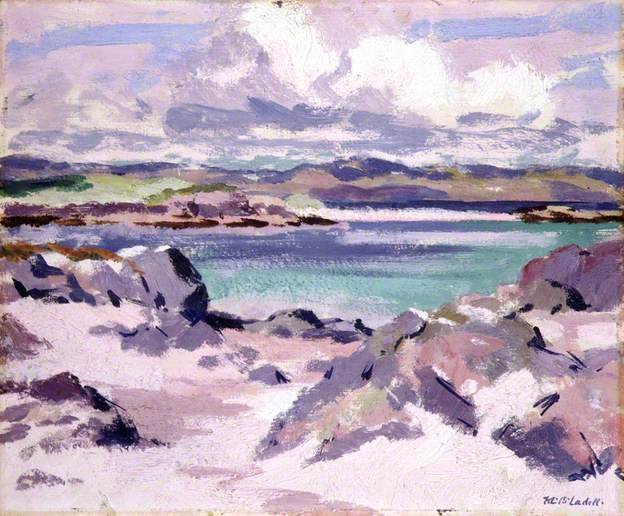
In 1912, Cadell made his first visit to the small Western Isle of Iona and fell in love with the beauty of the wild landscape. He found it an ideal place for painting because of the light, the colours of the white sand beaches and blue skies, and Iona’s geological diversity resulting in differing coloured rock formations. The rapid changing weather conditions around this area meant an en plein air artist had to work swiftly, but it was all worthwhile as the numerous stunning views provided plenty of incentive for keen artists. The island of Iona is low-lying and this results in the light reflected from the surrounding sea intensifying the colour of the water as well as the green of its pastureland. However, Cadell was of the opinion that any artist with any real sense of colour could only paint in Scotland during the summer and so he chose to work on Iona during the summer months, usually en plein air, and he would remain in Edinburgh and work in his studio during the darker days of spring and early autumn. A fine example of his Iona paintings highlighting the differing colours of the sea, rocks and sand was completed by him in 1920 and simply entitled Iona. After the First World War, Cadell would make annual pilgrimages to the island. He was not the only artist at the time to be drawn to the beauty of this Inner Hebridean Island as it attracted many other artists, including the Scottish Colourists, Peploe and Fergusson, and the Scottish landscape artist, John MacLauchlin Milne. In 1912 Cadell founded the Society of Eight. This was a group of like-minded artists, who rejected the artistic establishment of the day and, whose work was characterised by the use of bright colours.
In 1914 he applied to join the army but was turned down on medical grounds so for the next few months he took work on a farm as a labourer with the intention of improving his physical condition and fitness. All the exercise must have worked for in 1915 he re-applied to join the army and this time he was accepted and became a member of the 9th Argyll, 9th Royal Scots and the Sutherland Highlanders.
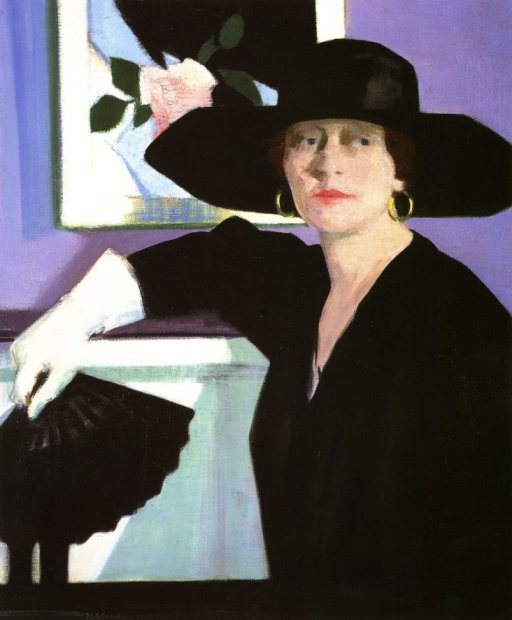
In 1921 Cadell completed one of his most popular works entitled Portrait of a Lady in Black. The sitter for this painting was his long-time muse, the enigmatic and mysterious, Miss Bethia Don Wauchope, who over a period of fifteen years, posed for twenty five paintings by Peploe and Cadell. In this work the setting is almost certainly the artist’s Ainslie Place studio in Edinburgh which Cadell had moved to the previous year. Miss Bethia Don Wauchope was a wealthy heiress of independent means. Little is known about Cadell’s muse accept that she was the eldest of four daughters, who never married and her father was Sir John Don-Wauchope, chairman of the Board of Education and Board of Lunacy. There is no doubt that she loved the thought of being immortalised in paintings. This was one of Cadell’s favourite works and we know he loved to work with Bethia as he went on to create a series of paintings with the theme ‘Lady in a Black Hat’, which included, Black Hat, Miss Don Wauchope, The Black Hat and in 1925 (Lady in Black) and 1926 (Interior, the Orange Blind).
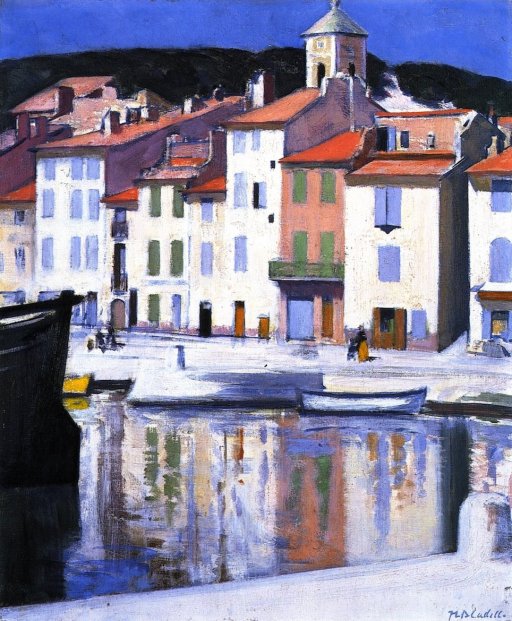
In 1923 Cadell embarked on a painting trip to the beautiful small seaside town of Cassis, on the French Mediterranean coast. The following year he produced some of his most radiant Colourist works while staying with fellow Colourist, Peploe. One of the works he painted there in 1923/4 was entitled The Harbour, Cassis and cleverly reflects the harsh Mediterranean light and the effect it has the surrounding buildings. Here the sun is so intense and the colours more vibrant. It is truly an artist’s paradise. (I was fortunate to visit this idyllic place a few years ago and was amazed by its charm and beauty).
Like most good things in life – they seem to have to end, and for Francis Cadell his lavish lifestyle in Edinburgh, which we saw reflected in many of his paintings of elegant women and opulent interiors, came to an end with the decline of the art market during the economic downturn of the late 1920s. Cadell, who had led a somewhat pampered and indulgent way of life was, like many others, badly affected financially and he was forced to sell part of his multi-storeyed Ainslie Place property. Things deteriorated further in the early 1930’s and sales of his works dwindled and he was even forced to move to a less expensive and salubrious residence.
In 1935 he was elected a member of the Royal Society of Watercolours and the following year he was made an Academician of the Royal Scottish Academy. Sadly, by 1936, his health was starting to decline and the following year, 1937, Cadell died, aged 54, the cause being given as cancer and cirrhosis of the liver.

Thanks for bringing this artist to my attention. I love his later paintings & am intrigued by Bethia.
Speaking, if I may, for your less visible audience, let me encourage you to continue your finely wrought essays despite what may seem a paucity of responses. Many of us, I’d guess, are not moved to comment unless driven by ire. Your presentation is thoughtful
and informative. Your love for a good painting is apparent. This moves us to read your
next post even when we faintly feel guilt for not responding to your last.
I’m trying to the identity of a Cadell portrait that I own. Who was Peggy Mcrae? And at what date did Cadell get to know Lady Lavery (in North Berwick , I presume.) Can you help?
Hi, are you related to CE Stewart who purchased Cadell’s paintings in the early days?